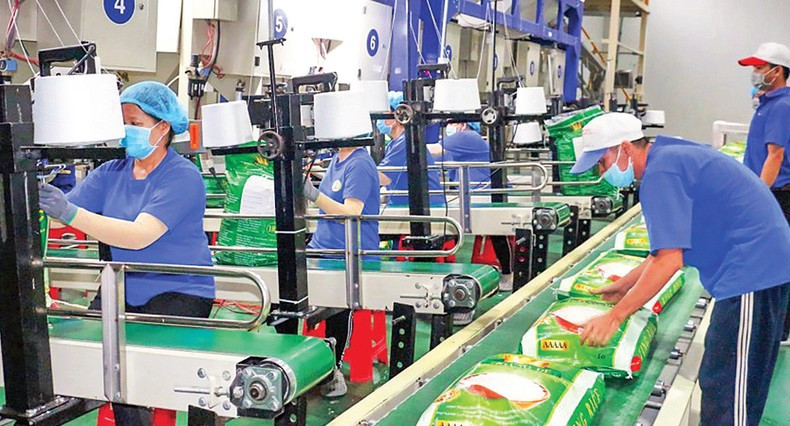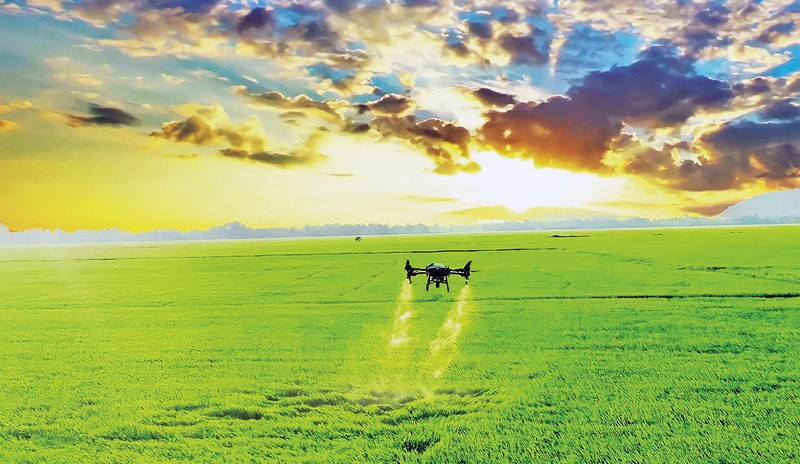There are six groups of agricultural exports with revenue exceeding 3 billion USD each, namely coffee, rice, fruit and vegetables, cashew nuts, shrimp, and timber. Vietnam enjoyed export growth in both established and new markets, while international partners were also particularly interested in the green production and growth of Vietnamese agriculture.
Fruit of technology
In the final days of 2023, the agricultural sector received a piece of good news: that Vietnamese rice won the world’s best rice award at a competition held by The Rice Trader within the International World Rice Conference Summit in Cebu, Philippines. As a company with two rice varieties participating and contributing to the victory of Vietnamese rice — namely Loc Troi 28 and Nang Hoa 9 — Loc Troi Group has pioneered in digital transformation and employing advanced technology in production.
Loc Troi Group Chairman Huynh Van Thon said the company has put a lot of effort into developing the Loc Troi 28 and Nang Hoa 9 rice varieties. Loc Troi 28 is a variety selected from more than 2,000 individual hybrids of Loc Troi 1 and Basmati since 2014. It is capable of withstanding pests and diseases while producing long, slender white grains, which are soft, glutinous, fragrant and sweet when cooked. Meanwhile, Nang Hoa 9 is the research outcome of agricultural engineer Le Hung Lan at Hoa Tien Seed Company, which granted ownership to Loc Troi Group and put the variety into production in May 2023. Nang Hoa 9 is one of the nine jasmine rice varieties exported to the EU that enjoy preferential tariffs under the EU-Vietnam Free Trade Agreement (EVFTA).
In the production, processing and export of fruits, the story of carbon footprint tracking for Vietnamese dragon fruit has also provided satisfaction and confidence to consumers as well as many of the most demanding importers in the world.
This model is jointly implemented by the UNDP and Vietnam’s Ministry of Agriculture and Rural Development (MARD) to track carbon emissions during the production and processing of dragon fruit in Binh Thuan Province. With this system, consumers can scan QR codes to track the degree of green practices in dragon fruit production.
In addition to crop production, Vietnam’s marine aquaculture is also reaping many successes with new advances in its aspiration to become Southeast Asia’s number one for marine aquaculture. MARD Deputy Minister Phung Duc Tien said Vietnam holds great potential in marine farming with a sea surface area of over one million square kilometres and the application of new technologies. Currently, Vietnam has established some industrial farms and needs to tap into this potential in a new situation.
Vietnam’s marine farming output reached 800,000 tonnes in 2023. By 2045, the industry is expected to become an important component of the country’s fishery sector, contributing one quarter of total fishery output and 4 billion USD in exports, thus helping to realise the goal of reducing natural harvesting and increasing farming in closed chains.
 |
| Packaging rice for export to the EU at the Can Tho-based Trung An Rice Company. (Photo: Nam Phuong) |
Growing exports
In 2023, Vietnam exported more than 8 million tonnes of rice and revenue hit a record of 4.78 billion USD. Vietnamese rice export prices also surpassed Thailand’s and topped the world.
From an exporter of mainly raw rice to a country with the world’s best rice, Vietnam is striving to become the first country to produce and export low-emission rice. Vietnam’s rice sector arguably stands a chance of making a momentous change and establishing itself in a leading position on the global rice export map in terms of output, quality and value alike thanks to incessant efforts to utilise science and technology.
Similar to with rice, 5.69 billion USD worth of fruit and vegetable exports in 2023 is also an outstanding result for those interested in the development of Vietnamese agriculture. Among them, passion fruit and durian are dominating the world market in terms of output and price. Achievements will not stop there since there remains huge potential for the fruit and vegetable sector.
According to Dinh Cao Khue, Chairman of Dong Giao Foodstuff Export Company — one of Vietnam’s leading fruit and vegetable exporters, if the Central Highlands switches from cultivating low-yielding short-term crops to high-yielding ones such as pineapple, passion fruit, and banana, the fruit and vegetable export revenue of Gia Lai Province alone could exceed 5 billion USD, equal to the country’s total export value. But he noted that such a result can only be achieved by stepping up the use of science-technology and forging a close bond between farmers and enterprises.
Vietnam can tap into the potential in other sectors such as coffee and fishery to bring in even higher added values, where the key to growth remains technology. It is also one of the reasons why in recent years the MARD has always put a focus on science-technology by removing institutional bottlenecks and adopting digital transformation to drive agriculture’s strong growth.
Stepping up the implementation of sectoral development strategies in the direction of integrating multiple values, increasing the content of science-technology in key stages, and especially applying high technology to the production and processing of main exports is the right path to enhance the value of Vietnam’s agricultural products.
As the global food crisis faces the risk of spreading further, the large volume of Vietnamese rice exports has affirmed both high domestic output as well as the country’s commitment to ensuring global food security.
















